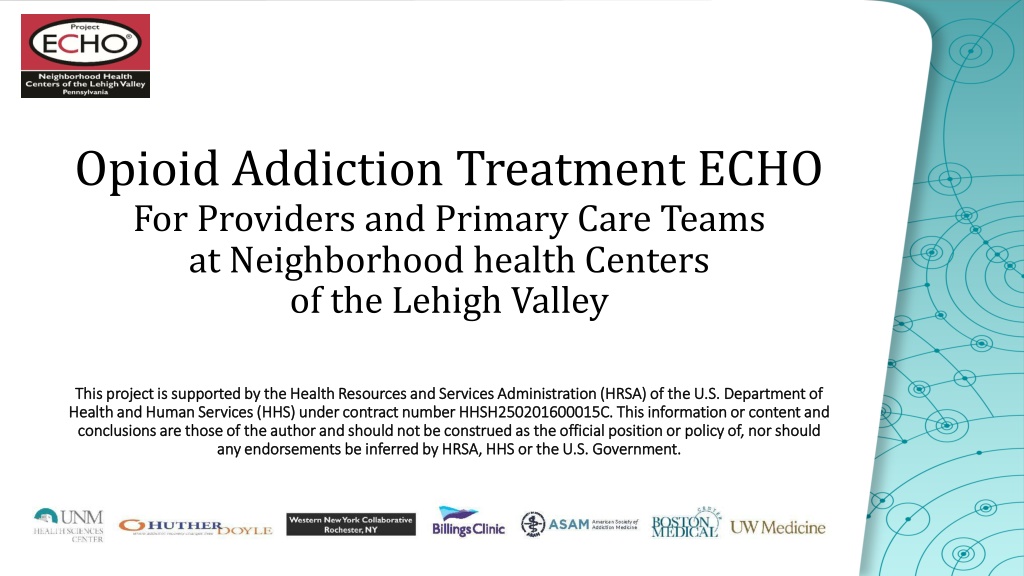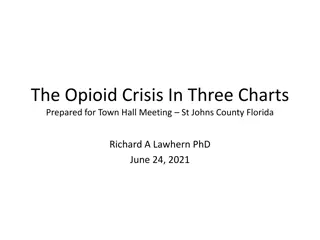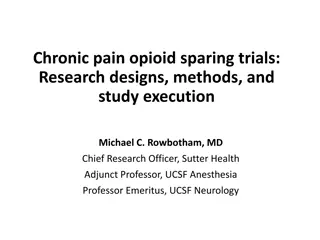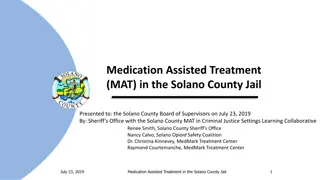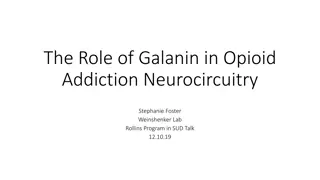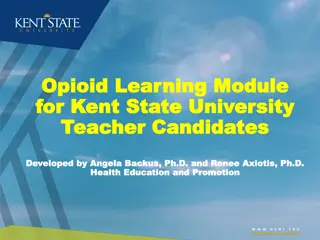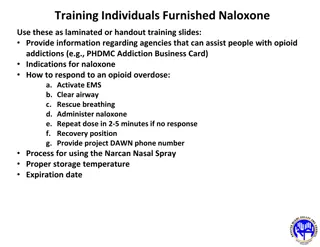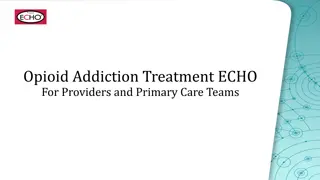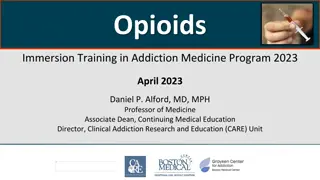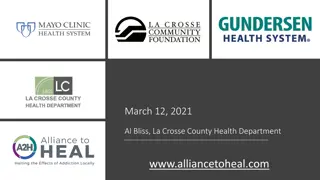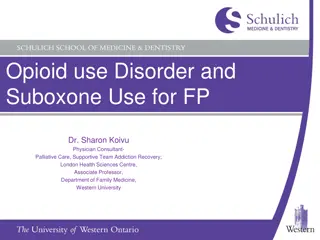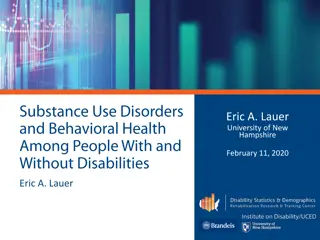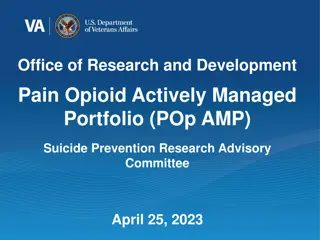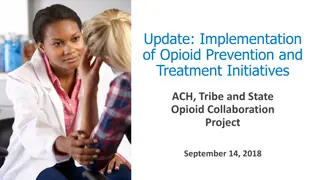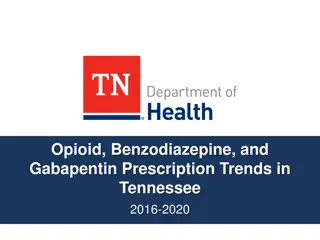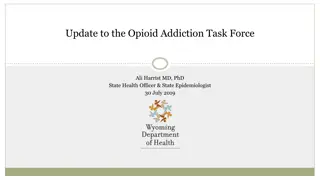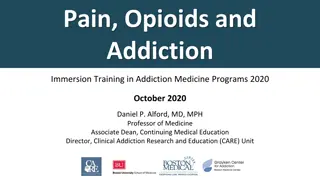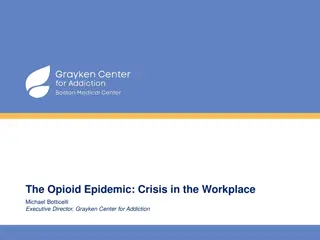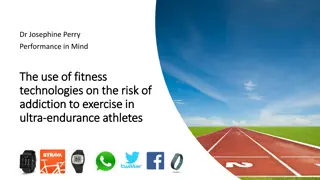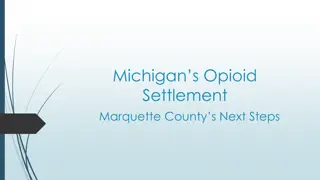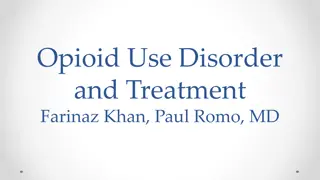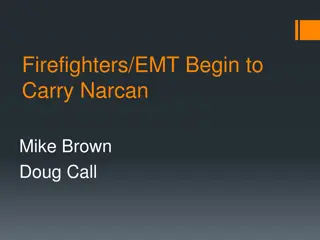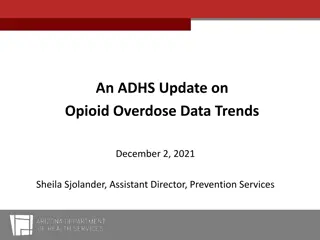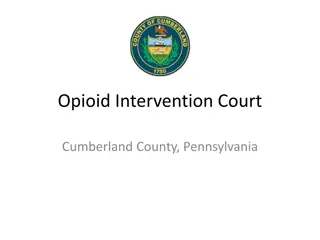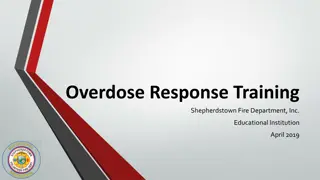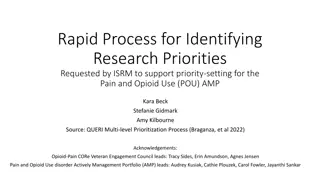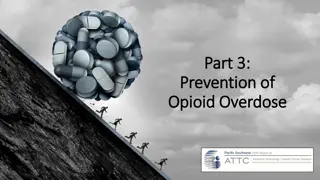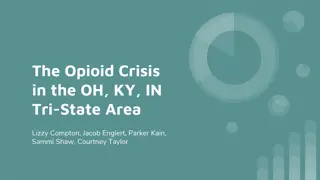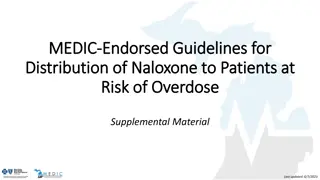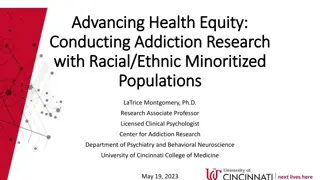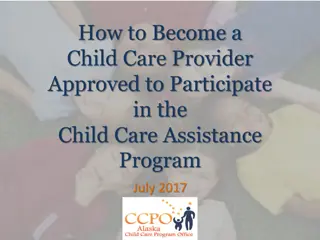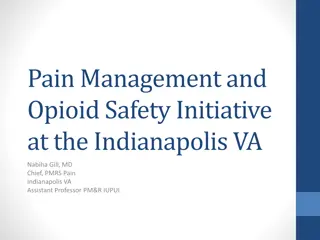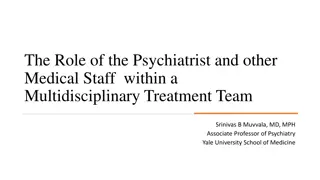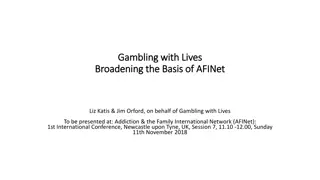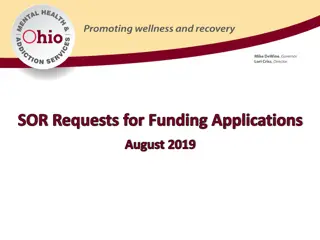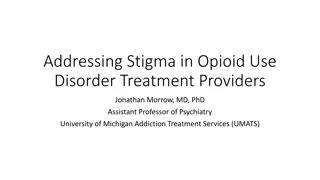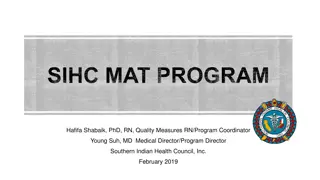Comprehensive Opioid Addiction Treatment Information for Providers
This project, supported by HRSA, provides valuable information on opioid addiction treatment, including medication options, effective interventions, and important considerations. Key topics covered include medication treatment, disclosures, medications for opioid use disorder, euphoria, and pharmacotherapy for opioid addiction. The content emphasizes the importance of maintenance medication like buprenorphine and methadone in saving lives and reducing relapse. Additionally, it highlights the benefits and challenges associated with various treatment approaches, such as methadone being highly regulated and dispensed at specialized programs, and the cost-effectiveness of investing in opioid addiction treatment. Provider training programs like ECHO aim to enhance primary care teams' capabilities in addressing opioid addiction within their communities.
Download Presentation

Please find below an Image/Link to download the presentation.
The content on the website is provided AS IS for your information and personal use only. It may not be sold, licensed, or shared on other websites without obtaining consent from the author. Download presentation by click this link. If you encounter any issues during the download, it is possible that the publisher has removed the file from their server.
E N D
Presentation Transcript
Opioid Addiction Treatment ECHO For Providers and Primary Care Teams at Neighborhood health Centers of the Lehigh Valley This project is supported by the Health Resources and Services Administration (HRSA) of the U.S. Department of This project is supported by the Health Resources and Services Administration (HRSA) of the U.S. Department of Health and Human Services (HHS) under contract number HHSH250201600015C. This information or content and Health and Human Services (HHS) under contract number HHSH250201600015C. This information or content and conclusions are those of the author and should not be construed as the official position or policy of, nor should conclusions are those of the author and should not be construed as the official position or policy of, nor should any endorsements be inferred by HRSA, HHS or the U.S. Government. any endorsements be inferred by HRSA, HHS or the U.S. Government.
Medication Treatment for Opioid Use Disorder Developer: Joe Merrill, MD, University of Washington, Charles Morgan MD, and Anne Griepp MD, Western New York Collaborative And Miriam Komaromy, MD, University of New Mexico Reviewer/Editor: Miriam Komaromy, MD, The ECHO Institute Presenter: Abby Letcher, MD, Neighborhood Health Centers of the Lehigh Valley, aletcher@nhclv.com
Disclosures Joe Merrill, Charles Morgan, and Ann Griepp and Miriam Komaromy have nothing to disclose.
Medications for Opioid Use Disorder Buprenorphine (sublingual and implantable) Naltrexone (oral and extended release injectable) Methadone Detox has no long-term effect on outcomes; it is medication maintenance that saves lives and reduces relapse
Euphoria Normal Withdrawal Medication Assisted Therapy Tolerance & Physical Dependence Chronic Use Acute Use Alford, Boston University, 2012
Pharmacotherapy for Opioid Addiction: Methadone Most effective survival, treatment retention, employment illicit opioid use, hepatitis and HIV infections, criminal activity Highly regulated, dispensed at Opioid Treatment Programs (OTP) Supervised daily dosing with take-home doses if stable Counseling, urine testing Psychiatric, medical services often not provided Illegal to prescribe methadone for addiction in general practice Cost-effective Every dollar invested generates $4-5 in savings
Pharmacotherapy for Opioid Addiction: Methadone Daily, observed dosing Full opioid agonist Onset within 30-60 minutes Long-acting: Daily dosing effective for addiction Dose 20-40 mg for acute withdrawal >80 mg for craving and blockade To evaluate stability, ask about take-home doses Multiple medication interactions Advise staying in treatment until social, medical, psychiatric, legal, and family issues are stable. Detox therapy has no long-term effect on outcomes Longer duration, higher dose treatment most effective For some patients methadone therapy should be lifelong, as risk of relapse is high after cessation
METHADONE DECREASES RISK OF HIV AND HEPATITIS C INFECTION Highly effective FACTS Can t nurse your baby One of the WHO list of 100 essential meds that should be available worldwide Always sedated MYTHS BAD FOR YOUR BABY BAD FOR YOUR BABY Rots your teeth
Pharmacotherapy for Opioid Addiction: Buprenorphine 2000 Federal Drug Addiction Treatment Act ( DATA-2000 ): Made office-based addiction treatment by physicians legal Must complete 8-hour training and obtain federal waiver 2002: Suboxone (buprenorphine/naloxone) FDA approved Outcomes much superior to psychosocial treatment alone Longer treatment duration is more effective Compared to methadone: Similar abstinence from illicit opioids and decreased craving Lower retention in treatment Can be prescribed in general practice, lowering barriers to treatment
Pharmacotherapy for Opioid Addiction: Buprenorphine Partial opioid agonist, so safer than methadone High mu receptor affinity, so blocks other opioids Formulated with naloxone - abuse deterrent Sublingual dosing and newer implant (Probuphine) Can precipitate withdrawal in tolerant patients Requires induction after patient enters mild-moderate withdrawal Home induction appears to be safe and effective, widely adopted Induction from methadone more difficult (taper to ~30 mg) Implant approved for stable patients on 8 mg buprenorphine
Why is Overdose Potential Low with Buprenorphine? Agonist: Methadone, Heroin, etc. Respiratory suppression, death Opioid Effects Partial Agonist: Buprenorphine Antagonist: Naltrexone Compton WM et al. N Engl J Med 2016;374:154-163 Log dose
Trial of Buprenorphine 40 people addicted to heroin Buprenorphine 16 mg/day vs taper + placebo All received indiv counseling + therapy groups Followed for 1 year Buprenorphine 16 mg per day Placebo Retained at 1 yr 75% 0 % died 0 20% Kakko et al, Lancet 2003
Buprenorphine in Primary Care Not widely used in primary care Most prescribers treat few patients, so poor access Barriers in primary care include: Urgency of scheduling Induction visit and frequent early follow up (consider home induction) Urine testing and prescription logistics Linkages to psychosocial services Difficult decisions about when to stop or refer Some physicians restrict prescribing to patients who were already in their own practice
Buprenorphine in Primary Care Advantages of buprenorphine in primary care: Setting built for chronic disease management Reduces the stigma of addiction treatment Reduced contact with active drug users Facilitates management of mental health and medical co- morbidities and preventive care Important tool when problems arise during chronic opioid therapy Public health benefit: increases local access to lifesaving care Highly gratifying form of treatment!
Emerging Models of Buprenorphine Care Massachusetts Nurse Care Manager Model Full time RN and Program Manager can screen and assess, perform induction and follow closely Prescriber time leveraged Regular team meetings aid in decision-making Allows primary care practices to involve multiple prescribers RN can follow 100-125 patients Hub and Spoke Model (Vermont) Centralized screening, assessment, stabilization Transfer to primary care sites for ongoing treatment
Naltrexone Opioid antagonist that blocks other opioids Does not lead to physical dependence, or to withdrawal when stopped Causes acute withdrawal in opioid-dependent patients Can be used in office-based settings without added training Effective in alcohol use disorder treatment Two formulations available: Oral ReVia 50 mg PO daily Injectable Vivitrol 360 mg IM monthly
Naltrexone for Opioid Use Disorder Requires opioid abstinence prior to initiation, a major barrier since most treatment-seeking patients are actively using opioids Difficult to compare with methadone or buprenorphine (trial underway) Russian studies show benefit in population where opioid substitution therapy is not available Mixed results in US populations (Cochrane reviews) Recent study (Lee, NEJM) in criminal justice population showed short term reduction in opioid relapse compared with usual care (not buprenorphibe or methadone), and reduction in overdose compared with no medication
Overdose Prevention Naloxone ( Narcan ) reverses opioid overdose Overdose education and naloxone is an effective harm reduction strategy For those at high risk of overdose and their friends or family Populations: syringe exchange, exit from jail, in drug treatment, high risk prescribed opioids Prescribe to Prevent educational modules: http://www.opioidprescribing.com/naloxone_module_1-landing
Summary: Medications for Opioid Use Disorder Prescription opioid and heroin epidemics are major public health problems Medications are an essential component of evidence-based treatment Methadone and buprenorphine are the most effective pharmacotherapies for opioid use disorder Naltrexone can also be used, but only in patients who are not currently physically dependent on opioids Primary care teams can play an important role in treatment of opioid use disorders and prevention of overdose
References: J Addict Med. 2014 Sep-Oct;8(5):299-308. doi: 10.1097/ADM.0000000000000059. Unobserved "home" induction onto buprenorphine. Lee JD1, Vocci F, Fiellin DA A comparison of buprenorphine induction strategies: patient-centered home-based inductions versus standard-of-care office-based inductions. Cunningham CO, Giovanniello A, Li X, Kunins HV, Roose RJ, Sohler NL. J Subst Abuse Treat. 2011 Jun;40(4):349-56 Statement of the American Society Of Addiction Medicine Consensus Panel on the use of buprenorphine in office-based treatment of opioid addiction. Kraus ML, Alford DP, Kotz MM, Levounis P, Mandell TW, Meyer M, Salsitz EA, Wetterau N, Wyatt SA; American Society Of Addiction Medicine.. J Addict Med. 2011 Dec;5(4):254-63. doi: Collaborative care of opioid-addicted patients in primary care using buprenorphine: five-year experience. Alford DP, LaBelle CT, Kretsch N, Bergeron A, Winter M, Botticelli M, Samet JH. Arch Intern Med. 2011 Mar 14;171(5):425-31.
Buprenorphine maintenance versus placebo or methadone maintenance for opioid dependence. Mattick RP, Breen C, Kimber J, Davoli M. Cochrane Database Syst Rev. 2014 NIDA (2016). Understanding Drug Abuse and Addiction: What Science Says. Retrieved January 2, 2017, from https://www.drugabuse.gov/understanding-drug-abuse-addiction-what-science-says Psychosocial combined with agonist maintenance treatments versus agonist maintenance treatments alone for treatment of opioid dependence. Amato L, Minozzi S, Davoli M, Vecchi S. Cochrane Database Syst Rev. 2011 Oct 5;(10):CD004147 Lancet. 2003 Feb 22;361(9358):662-8. 1-year retention and social function after buprenorphine-assisted relapse prevention treatment for heroin dependence in Sweden: a randomised, placebo-controlled trial. Kakko J1, Svanborg KD, Kreek MJ, Heilig M. Am J Public Health. 2013 May;103(5):917-22. doi: 10.2105/AJPH.2012.301049. Epub 2013 Mar 14. Opioid agonist treatments and heroin overdose deaths in Baltimore, Maryland, 1995-2009. Schwartz RP1, Gryczynski J, O'Grady KE, Sharfstein JM, Warren G, Olsen Y, Mitchell SG, Jaffe JH
Cochrane Database Syst Rev. 2008 Apr 16;(2):CD006140. doi: 10.1002/14651858.CD006140.pub2. Sustained-release naltrexone for opioid dependence. Lobmaier P1, Korn r H, Kun e N, Bj rndal A N Engl J Med. 2016 Mar 31;374(13):1232-42. doi: 10.1056/NEJMoa1505409. Extended-Release Naltrexone to Prevent Opioid Relapse in Criminal Justice Offenders. Lee JD1, Friedmann PD1, Kinlock TW1, Nunes EV1, Boney TY1, Hoskinson RA Jr1, Wilson D1, McDonald R1, Rotrosen J1, Gourevitch MN1, Gordon M1,Fishman M1, Chen DT1, Bonnie RJ1, Cornish JW1, Murphy SM1, O'Brien CP1 Lancet. 2011 Apr 30;377(9776):1506-13. doi: 10.1016/S0140-6736(11)60358-9. Injectable extended-release naltrexone for opioid dependence: a double-blind, placebo-controlled, multicentre randomised trial. Krupitsky E1, Nunes EV, Ling W, Illeperuma A, Gastfriend DR, Silverman BL. Office-Based Opioid Treatment with Buprenorphine (OBOT-B): Statewide Implementation of the Massachusetts Collaborative Care Model in Community Health Centers. LaBelle CT, Han SC, Bergeron A, Samet JH. J Subst Abuse Treat. 2016 Jan;60:6-13.
Collaborative care of opioid-addicted patients in primary care using buprenorphine: five-year experience. Alford DP, LaBelle CT, Kretsch N, Bergeron A, Winter M, Botticelli M, Samet JH. Arch Intern Med. 2011 Mar 14;171(5):425-31. Prev Med. 2015 Nov;80:10-1. doi: 10.1016/j.ypmed.2015.04.002. Epub 2015 Apr 11. Vermont responds to its opioid crisis. Simpatico TA1 J Addict Med. 2016 Sep-Oct;10(5):300-8. doi: 10.1097/ADM.0000000000000223. Prescribe to Prevent: Overdose Prevention and Naloxone Rescue Kits for Prescribers and Pharmacists. Lim JK1, Bratberg JP, Davis CS, Green TC, Walley AY
